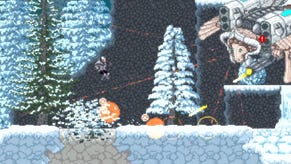Axiom Verge Review: Play it Again, Sam [Updated for Vita]
Think you're tired of retro Metroidvania games? You obviously haven't played Axiom Verge yet.
This article first appeared on USgamer, a partner publication of VG247. Some content, such as this article, has been migrated to VG247 for posterity after USgamer's closure - but it has not been edited or further vetted by the VG247 team.
Note: You can find our updated thoughts on the Vita version on page 2.
Jaz Rignall, Editor-at-Large
If you're going to clone a classic, much-loved game series, you'd better make sure what you're doing stands up to history. Fortunately, developer Tom Happ has done just that with Axiom Verge – and then some.
An unabashed tribute that at first, and perhaps even second glance could easily be construed as an original NES game running on PS4, Axiom Verge uses a Metroid blueprint as its foundations, and builds upon it something old, yet something new, weaving in deft control and design touches from other games of the period, like Blaster Master, Star Control, and Contra. The result is a Metroidvania par excellence; one of the most engaging and addictive I've played in years.
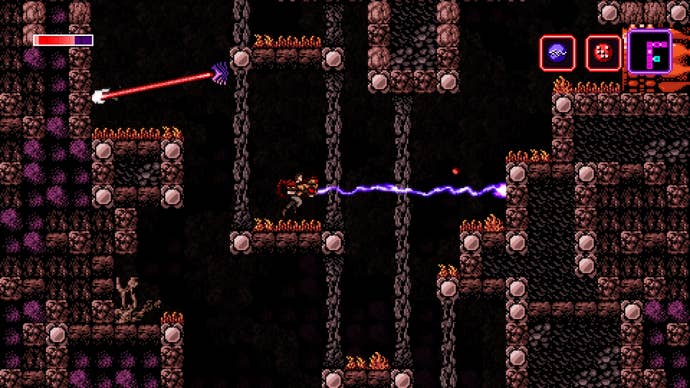
As you've no doubt already ascertained by the screenshots, this thing is an authentic retro game. No Ori and the Blind Forest here, with modern-day visuals festooned over a Metroidvania framework. No sir. Axiom Verge goes the whole retro hog. It's in the little things. Anyone who gamed through the late 80’s and early 90’s will love the meticulous attention to detail poured into the game’s looks and cut scenes. The backgrounds are authentically tiled, colors and black space have been cleverly used to create period-style shading and depth, and even the way the enemies move and fire feels absolutely spot-on. The music is period chiptune – seamlessly mixed in with brilliant contemporary music - as are the sound effects. And the control scheme will be instantly familiar with anyone who's played the original Metroid games. Even the story is told in what feels like slightly mistranslated, occasionally grammatically broken English. It's like somebody blew on a rediscovered NES cartridge, stuffed into the front of your PS4, and it magically worked.
The gameplay is the key factor of any Metroidvania game, and it's not just about making a good platform game. There are design subtleties that need to be imbued into the game to really make it sing, and initially I was concerned that Axiom Verge hadn't quite gotten everything right.
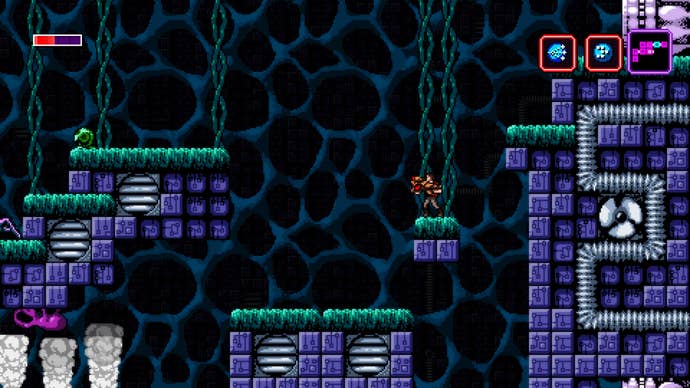
What I found at first is that I became annoyed at the save points. Sometimes they seemed to be just a little too far apart. They'd have some tricky platforming and enemy-dodging between one and another and I'd die repeatedly, knowing that I must be close to that next point. I'd gnash my teeth and swear under my breath before taking another deep one and soldiering forth for yet another attempt to overcome whatever hazard was stymieing me, hoping that this time I would finally best it.
And therein lies the rub. I might have been angry at the game for being frustrating, but deep down I knew that it was actually me – and the fact that I was forgetting that this is the way that these games are supposed to be. Impatience is the bane of my life, and inevitably that was the real root of my problem. Perhaps I'd not held back and taken a few long shots at an alien before moving in. Perhaps I'd just rushed a series of platforms and missed one, sending me plummeting into an enemy or a pool of toxic goo.
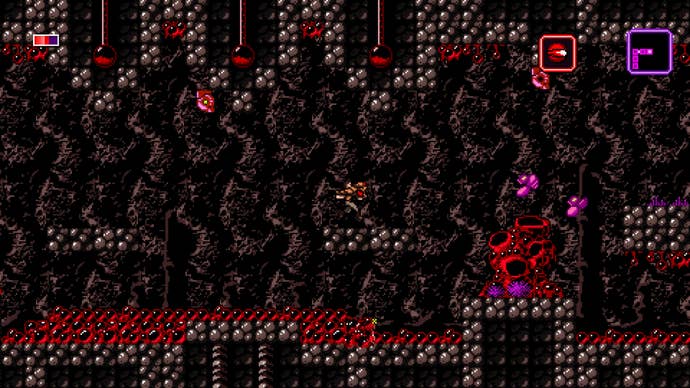
This is classic oldschool gaming philosophy, and it needs to be applied to Axiom Verge. The game is extremely well designed to be tough, but fair. If you concentrate, take your time and are methodical about working through the game, it's all doable. It's just that you need to be strategic about the way you play – which is exactly how the classic greats have always been. You die. You get annoyed. And then you gird your loins and continue forward, but not without first thinking about why you died so that you can avoid making the same mistake again. At least, you do if you're not impatient.
And yes, sure, that's the way that every game is supposed to work, but the difference here is that the level of challenge is gauged just right, and the depth of the game's mystery pitched beautifully to keep calling you back. What's around the next corner? What cool weapon will you find next? What will the next boss look like? What the hell is beyond that doorway that you can't quite reach yet – but you know you'll eventually get something that will let you jump that little bit higher so that you'll be able to access it, or squeeze though the gap that's thwarting you?
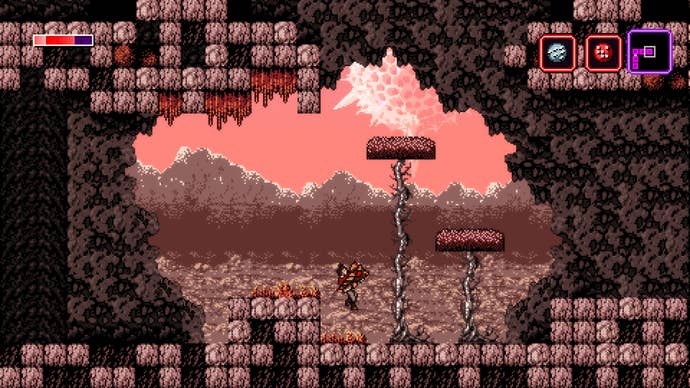
All these questions are part of the Axiom Verge experience. They're the same ones that helped make those original classic Metroid games so addictive, and they work again here.
Which of course begs the question – if this is such a close copy, why not just play the real Metroid or Super Metroid and enjoy an original classic, rather than something that emulates them? For me, the answer is a simple one: because this is also a great game in its own right. It might be incredibly similar to the games from which it takes its inspiration, but it adds new ideas and design features. Like the clever glitching mechanism that lets you sneak through walls, almost like you’re exploiting the game – or the guns that let you change slightly corrupted-looking graphics into solid platforms or work your way through previously impassable barriers so you can access a new area.
Like I said, this is a period authentic game, and there's a certain degree of warts-and-all about Axiom Verge's save points and level of difficulty, about some of the jumps you need to make, and the pattern-learning of the boss battles. Indeed, I'm sure some people will play this and wonder why on earth I'm enthusing over it, perhaps finding those sometimes long, repeated treks through to the next save room just too frustrating, or a particular boss battle infuriating in the way that it requires you to follow a routine in just the right sequence. But that's the way this kind of game works. It's like sitting down to play the Dark Souls series and wondering why it's tough. That's just the way it is.
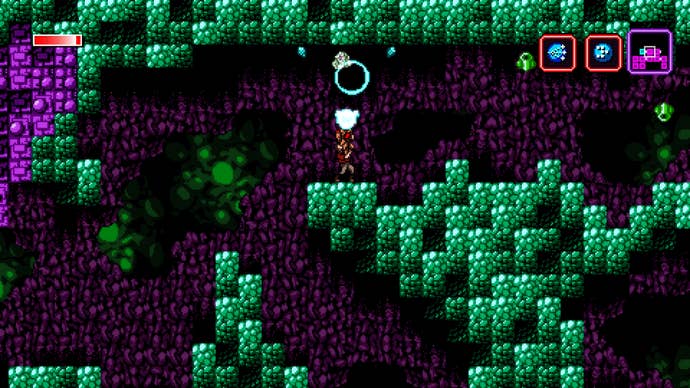
But tough though it may be, I've really enjoyed playing Axiom Verge. It's a throwback that brings forth some new ideas to a genre I thought I'd grown tired of. Retro-style Metroidvania games have been commonplace of late, but this one really shows how it's done. You can feel the love and attention to detail that's been lavished upon it. The way that it plays. The way the maps have been designed. The way boss battles work. The way that the hero jumps and moves. This game has been polished repeatedly and it shines through and through.
One final set of thoughts. If you've read through this review and reached this point, you'll have noticed I haven't really gone much into the specifics of the game's features and storyline. That's because I don't want to spoil this game at all. Axiom Verge is what would have been called an action adventure back in the day, and it's a brilliant one. It has twists and turns. The way the weapons and special abilities are doled out is thoughtful and sometimes surprising, and the storyline really is fascinating. So I'm not going into any details about them, and am instead using broad brushstrokes to describe the game as a whole. And without wanting to repeat myself, that's because it's one absolutely terrific experience. Whether you're an oldschool Metroidvania fan, or are new to them and want to understand what they're all about, Axiom Verge really delivers the goods.
So prepare to be occasionally frustrated, and to sometimes have to do things repeatedly until you get them right, but those tribulations will soon be forgotten as you experience the joys of this game's triumphs. When you finally work out how to kill that annoying boss, or after wandering around looking for the next part of the map and suddenly figuring out what it is you're missing, or when you realize what the new weapon or item you just picked up will actually let you do. Those are the moments that will make you whoop with delight - and make this game one to absolutely savor.
Who says they don't make 'em like they used to?
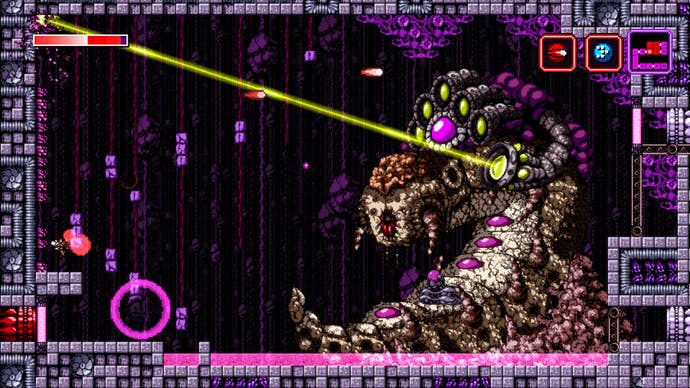
Jeremy Parish, Editor-in-Chief
Thirty dollars may not seem like much today, but back in 1988 it was a lot of money... especially for a kid on a monthly allowance of ten bucks. Thirty dollars is what I paid for Metroid, the first game I bought for my NES, and it was the only game I could afford to own until I saved up enough for another. So I wrung as much content out of Metroid as I could possibly contrive to do — completing speed runs, mapping the world, trying to come up with alternate routes and sequence-break. Not that "speed runs" and "sequence breaking" were part of the video games lexicon in those days, but even if I didn't have a term to describe what I was doing, I did my level best to explore and exploit Metroid to its fullest.
It was around this time that Nintendo published a "cheat" to discover "secret worlds" in Metroid. Like the "Minus World" in Super Mario Bros., Metroid's secret areas were the result of a programming error: A way to push the game code, already working hard to do a great deal within very tiny memory constraints, beyond its limits and enter spaces that were never intended to exist in the game. And as with the Minus World, you needed to behave in unorthodox ways to find these places.
The Nintendo Fun Club Newsletter exhorted players to venture forth and explore these mysterious worlds, I suppose as an effort to maintain a sort of corporate face about kids glitching out their game. And explore them I did, scrupulously working heroine Samus Aran up through the walls of each of the game's vertical shafts into rooms that technically didn't exist. Usually my hard work would result in her simply crawling off-screen to become stuck somewhere out of sight, the game still playing sound effects for her taking damage from unseen monsters and hazards. But every once in a while, her journey out of the game's boundaries would take the camera along and let me bear witness to her trip through bizarre fragments of code, creating a version of Metroid that the programmers never intended. In those moments, I really did feel like an explorer into the unknown.
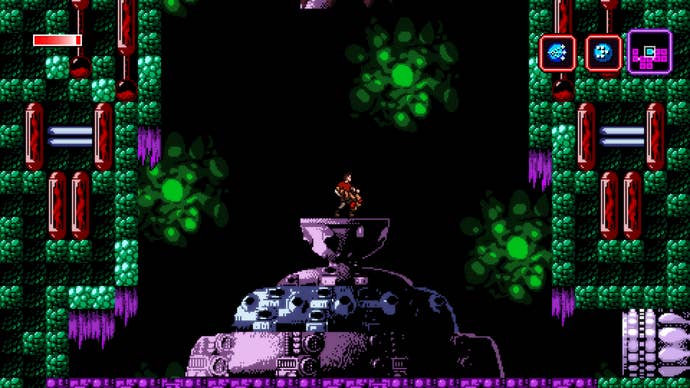
Tom Happ's Axiom Verge appears to have been built around that entire experience: Of being a kid poking around inside a game's code, of the illicit thrill of turning an adventure inside-out by traveling beyond its intended boundaries. It taps into a collective experience shared by countless old fans of NES games, creating a sort of controlled sensation of chaos. Unlike Metroid, Axiom Verge's glitches are a deliberate part of the game design and won't cause the code to break. Yet the game perfectly captures the feeling of those early days of console gaming, the spirit of venturing beyond the game's intended parameters.
It would be easy to write off Axiom Verge as just another grab for Gen X nostalgia, another shallow fake-retro game lazily using 8-bit graphics without rhyme or reason. The game adeptly captures the look of NES favorites like Metroid and Blaster Master, and like so many other indie platformers, it falls directly into the "metroidvania" category. But unlike the vast majority of its peers, Axiom Verge looks and plays the way it does for very specific reasons. It comes not from a place of ill-informed nostalgia or simply an attempt to cash in on a trend, but rather because it's driven by a desire to capture a fleeting, ephemeral sensation of experiencing the unknown. It looks "old" because, weirdly enough, that was the best way to accomplish something new.
Axiom Verge offers the freshest, most inventive take on old-school visuals and metroidvania play design I've seen in years. With all due respect to beautiful and clever games like Guacamelee or Ori and the Blind Forest, those adventures were built on a safe, predictable formula. Their designers clearly broke down the structures and mechanics of Super Metroid — understandably, as Super Metroid was a masterpiece — and as a result, they felt terribly predictable in their rhythms. You spot out-of-the-way areas or obstructions and can guess which power you'll be collecting to bypass those obstacles and, quite often, the order in which they'll be appearing. Not so with Axiom Verge.

It's been a long time since I've played a game like this without knowing exactly what would be coming next, but Axiom Verge had me guessing to the very end. Between its mind-bending storyline and unconventional power-ups, Axiom Verge breaks free of the Metroid formula like Samus of old wall-walking her way into a glitched cavern, playing with the structure of the game world and the digital nature of the game itself to force you to approach exploration in new and unexpected ways. For every standard power-up you uncover, like the ability to jump higher, you'll acquire several that you've never seen before. So even when you see puzzles that remind you of situations straight from an old game like Metroid, the mechanics for solving them are completely different than you'd expect. Protagonist Trace can't roll into a ball to pass through narrow gaps like Samus can — and the solution you eventually come across for reaching into those spaces results in a completely different form of gameplay than simply rolling to the next area. At every turn, Axiom Verge seems determined to change up conventions and keep players guessing.
Axiom Verge knows exactly when and how to mimic the classics, but it also refuses to lean on others' work. As a result, it captures a spirit I never thought I'd feel in a game like this again: That sense of mystery and unpredictability that drew me into exploratory NES games like Metroid, Blaster Master, and even lesser games like Rambo. Axiom Verge never holds your hand, choosing instead to let you explore at your own pace. It evokes the atmosphere and spirit of those pioneering action titles of so long ago, from color choices to the obsession so many NES designers had with biological horror, distilling them into a package far more palatable to contemporary tastes. It's fairer, less punishing, more thoughtfully balanced than the games that inspired it, choosing to let players find their own way through its bizarre, glitched-out world at their own pace — yes, even letting them become hopelessly lost. And yet, it never frustrates like NES games did.
I realize even as I look back fondly on NES classics that they can be tough to love in this day and age. Axiom Verge brings up-to-date sensibility to its design, using dated graphics not for superficial style but rather as an essential connection to its emphasis on glitching and code corruption. It captures the look and spirit of the 8-bit greats, but more importantly it rekindles their pioneering spirit as well rather than simply retreading the ground where those greats planted their flags so long ago. It employs familiar visuals to evoke a bygone sense of newness — and more than being an impressive parlor trick, it makes Axiom Verge simply one of the best games I've played in years.
InterfaceVery simple 8-bit style interface that works great.
Lasting AppealIt's no walk in the park, and if once you've completed it, you can always go back and try the speedrun mode if you want a real challenge.
SoundTop-notch chiptunes and effects seamlessly mixed with contemporary music evoke a wonderful atmosphere.
VisualsAuthentic period graphics are surprisingly moody and effective.
ConclusionAlthough it closely follows the Metroidvania blueprint, the brilliantly designed and executed Axiom Verge adds enough new and original features to make it a truly great game in its own right. An absolute must for retro fans.
Jeremy: By this point, I've said enough nice things about Thomas Happ's Axiom Verge that they could probably just send out a press release consisting of nothing but my quotes. I loved the game on PlayStation 4, continued loving it after letting the experience sink in for a few months, and even cherish the soundtrack I picked up on vinyl earlier this year.
Up until now, though, I've actually considered my time with the game to be slumming it, in a sense. Much as I enjoyed exploring the game on PlayStation 4, I've personally been holding out for the Vita version. My heart really belongs to portable systems, and I love Vita in all the ways that Sony clearly doesn't. 3DS may have the superior library thanks to a manufacturer that, you know, actually supports it, but the Vita as a portable device simply can't be topped. The system seems like it would be the perfect home for a game like Axiom Verge; portable consoles tend to be much kinder to retro-style action games than TV-based systems, and it's not like Axiom Verge's 2D side-scrolling visuals should tax a system as powerful as the Vita.
Much to my surprise, though, I've found myself walking away from my eagerly anticipated Vita run-through of Axiom Verge after only a couple of hours with it. What should be a perfect union of software and system won't quite sync up, and all playing the game on Vita has ultimately accomplished for me has been to instill an urge to go back and play it again on PS4. I'm disappointed, but I suppose in hindsight I shouldn't have been.
Visually, at least, Axiom Verge looks incredible on Vita. I initially played through it on a 40" screen, which is great for immersive 3D games like Far Cry Primal but does have a tendency to transmute pixel-art games like Axiom Verge into a sort of abstract Magic Eye experience in which you sometimes have to let your vision go slightly out of focus to see the game the way it was meant to be viewed. No such problem exists with the Vita version: Shrunken down to a tenth the size with the deep, rich blacks of the original model's OLED screen, Axiom Verge looks utterly gorgeous. The vivid, faux-8-bit neons of the game world pop explosively from areas of black as deep and dark as the night sky. The only way the game could possibly look better would be to somehow hook it up to a high-end CRT television to get some scanlines and phosphor glow going on to complete the look.
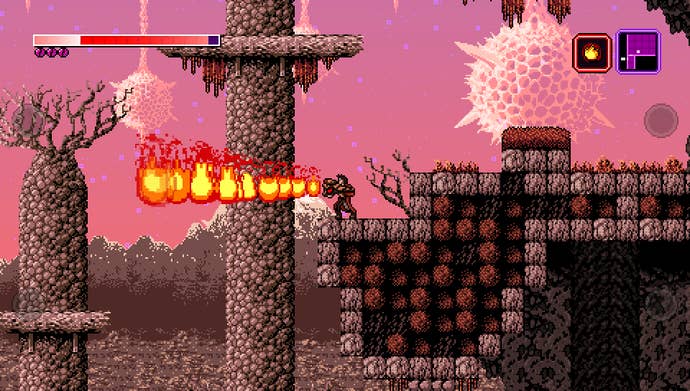
That would be tough to do, of course, because Axiom Verge was designed for HD consoles, and high-definition CRTs aren't easy to come by. Therein also lies the problem with this conversion of the game: It was clearly designed for a more capable system than the Vita, and cramming it into the Vita's limitations demanded a certain degree of compromise. Unfortunately, the degree to which it had be compromised takes the overall experience to a point that undermines its playability.
You can see the Vita struggling with the game quite often in the forms of slowdowns, awkward pauses, and overly lengthy loading times — problems the PS4 never suffered from. In some cases, the slowdown doesn't seem so egregious; when you move into large, open spaces full of enemies, the action drags out momentarily... just like Axiom Verge's inspiration, Metroid. It's not an intentional nod, but in a game built so heavily around fond reminiscences of that NES classic, it doesn't feel at all out of place. For the most part, though, the technical errors have a much less heartwarming effect. The unpredictable hitches in the action, where everything stops moving altogether for a fraction of a second or longer, create the sensation that the whole affair is about to come crashing down. I've experienced a few pauses that lasted long enough I was shocked when the game didn't crash outright.
While I'm not one to rail on about minor performance issues, in this case the Vita version's flaws betray one of the fundamental principles of the game. Axiom Verge revolves around the concept of computer glitches and errors, but strictly those under the player's control. In order for that concept to work, the game has to run silky-smooth so that your own abuses of the virtual environment stand out. When the game sporadically misbehaves, the impact and integrity of the deliberate glitching disintegrates. Axiom Verge invites the player to tear about its digital universe... but when the universe seems on the brink of flying apart all on its own, it becomes harder to appreciate the cleverness of the underlying design.
Plus, despite its retro looks, Axiom Verge depends very much on modern controllers. The PlayStation 4 game made full use of every input option available on the DualShock 4, and it becomes awkward to control when squeezed into a system with fewer buttons. The Vita port maps key functions to corners of the touchscreen, complete with handy, barely visible translucent circular overlays at the edges of the screen to indicate the hot spots, but in practice it doesn't quite do the trick. The game's secondary functions (aim-lock, the drill, the "glitch gun," etc.) sat on the PS4's shoulder buttons, allowing you to run and jump around while making free use of those features. On Vita, only two of those four functions can fit on the shoulder buttons with the remainder relegated to touch inputs.

This, too, has a tremendous impact on the game experience, as much of the Axiom Verge experience involves running around testing the effects of your support tools on the environment. By forcing you to hold the touch screen to activate these powers, the Vita version removes much of your mobility (you can't hold down the touch screen and tap X to jump without some remarkably nimble finger skills, after all) and bogs down the pacing of the action. You can remap all the controls however you like, but I've yet to find a solution that works as well as playing on a DualShock 4. I've also discovered that in playing fast-paced action games, my right thumb tends to bump into the right stick more often than I realized; I've lost count of how many times I blew the rhythm of an intense shootout by accidentally brushing the stick and bringing up the weapon select menu.
Don't get me wrong: Underneath it all, Axiom Verge on Vita is the same great game as it was on PS4 and Steam. But it doesn't perform as well or control as well, and for a game as finely tuned as this, those minor hitches make this a less-than-ideal format for experiencing the game. Thankfully, Sony's cross-buy means that anyone who picks up the game on Vita also has access to the PS4 version, but that doesn't make the imperfections of this port any less disappointing. Axiom Verge and Vita should be a marriage made in heaven, but in the end I just found myself wishing mom and dad would stop fighting. The game remains as great as ever, but subtract a point from the score if you're playing on Vita.
InterfaceVery simple 8-bit style interface that works great.
Lasting AppealIt's no walk in the park, and if once you've completed it, you can always go back and try the speedrun mode if you want a real challenge.
SoundTop-notch chiptunes and effects seamlessly mixed with contemporary music evoke a wonderful atmosphere.
VisualsAuthentic period graphics are surprisingly moody and effective.
ConclusionAlthough it closely follows the Metroidvania blueprint, the brilliantly designed and executed Axiom Verge adds enough new and original features to make it a truly great game in its own right. An absolute must for retro fans.

.jpg?width=291&height=164&fit=crop&quality=80&format=jpg&auto=webp)
